Life Catholic

Bishop Greg’s Christmas message: ‘This is the season of hope’
Exciting new vision for the Diocese
We celebrate the end of the school year


Bishop Greg’s Christmas message: ‘This is the season of hope’
Exciting new vision for the Diocese
We celebrate the end of the school year
It’s a time for family, friends, and festivities, a season of rejuvenation and bonding

Visit the Diocese of Lismore website

We welcome submissions of articles and high-quality photographs to be sent to the editor at:
media@lismore.catholic.org.au
While we strive to publish submissions, please note that this cannot always be guaranteed, and content may be edited for space and clarity.
Published by Diocese of Lismore
Editor: Barry de Silva
Editorial committee: Joe Pereira, Margaret Haydon, Fr Peter Wood, Greg Isaac, Barry de Silva.
© 2024
The Diocese of Lismore
No part of the magazine may be reproduced in any form without prior written consent from the Bishop of Lismore. All the content and photographs that appear are used for the purpose of the magazine, with the prior permission of those concerned.





For a brief time, each year our thoughts turn from the business and worry of life to a newborn child in a manger. In the silence of Christmas night, we hear the secret hopes of our hearts and rekindle the trust and gaze of our childhood. The past is gone, if only we could fashion our future from the joy of Christmas. This is a season of hope in which we are called to believe in goodness, truth and beauty. Moreover, we are challenged to believe in ourselves and each other.
As we look at the crib we tend to identify with the baby. Curiously we do not associate with Mary or Joseph, and certainly not with the shepherds or the wise men. The baby Jesus carries our hopes, our fears and our future. He does not threaten us, we are not afraid of him. God comes into the world as a baby so that he can grow
with us. We can also grow with God. Jesus shares each of our pains, difficulties and joys. In the baby, God and humankind are one. Jesus comes into the world to show us how to believe in ourselves and each other with confidence.
Take some time to pray. In prayer we are moved by Christmas. Suddenly joy becomes part of us, and we begin to see life with greater optimism and hope. This is the miracle of Christmas. May you be gifted with the spirit of Christmas.
With my prayers and wishes this Christmas and New Year.
Bishop Greg Homeming OCD
This is a season of hope in which we are called to believe in goodness, truth and beauty.



by Fr Joe DSouza
May we celebrate with purpose, gratitude, and may we have a renewed commitment to spreading love, peace, and joy.
As Christmas approaches, our hearts swell with joy, and our homes come alive with colourful lights, music, and laughter. It’s a time for family, friends, and festivities, a season of rejuvenation and bonding. But amidst the celebrations, let’s not forget the true meaning of Christmas – the birth of our Saviour, Jesus Christ (Luke 2:1-20).
Growing up in Belagavi, India, Christmas held a special place in my heart, largely due to the vibrant traditions and interfaith celebrations that filled our home. In our neighbourhood, festivities brought people together, transcending religious boundaries. It was a custom for women from neighbouring families — Christian, Hindu, and Muslim — to gather at each other’s homes, sharing recipes and laughter as they prepared traditional sweets like Kuswar.
As kids, we’d eagerly watch the sweets being made, sampling a few (or more!) of each and creating a mess, but also listening with wonder to the women’s stories.
This beautiful blend of cultures and faiths taught me the importance of unity, kindness, and generosity. On Christmas Eve, I’d sing in the choir during Midnight Mass, and the next morning, I’d serve at the altar and be the thurifer. When I’d arrive home, having the opportunity to share Kuswar with loved ones, neighbours, and the elderly brought even more joy.
These simple acts of kindness and community taught me the value of love, generosity, and compassion; shaping my understanding of the true spirit of Christmas, a celebration of love, unity, and the gift of salvation through Jesus Christ. As I reflect on those childhood experiences, I realise that Christmas is more than just a cultural celebration; it’s a time to commemorate our salvation, made possible by God’s gift of his Son, Jesus Christ (John 3:16).
Today, the world needs Jesus more than ever. He is the Prince of Peace (Isaiah 9:6), the Joy to the world (Psalm 96:11-13), and the King of glory (Psalm 24:7-10). When He dwells in our hearts and minds, even the most unlikely of friends–the lion and the lamb–can live in harmony (Isaiah 11:6-9).
In a world torn apart by war, hatred, and division, Christmas reminds us of the power of love and unity. As we celebrate the birth of Jesus, let’s not forget the countless individuals and families displaced, suffering, or struggling for survival. Let’s extend a hand of kindness, generosity, and compassion to those in need. May our celebrations be a beacon of hope, shining the light of Christ to a world desperate for peace and harmony.
This Christmas, let’s come together in Christ, acknowledging our shared humanity and our need for a Saviour. As we exchange gifts, let’s remember the greatest gift of all–the gift of salvation through Jesus Christ (Ephesians 2:8-9).
May this Christmas season bring us closer to our Lord and to each other. May we celebrate with purpose, gratitude, and may we have a renewed commitment to spreading love, peace, and joy to all those around us, shining the light of Christ to a world in need.
As we consider the true meaning of Christmas, let’s reflect on the words of Jesus: “Love each other as I have loved you” (John 15:12).





by Barry de Silva
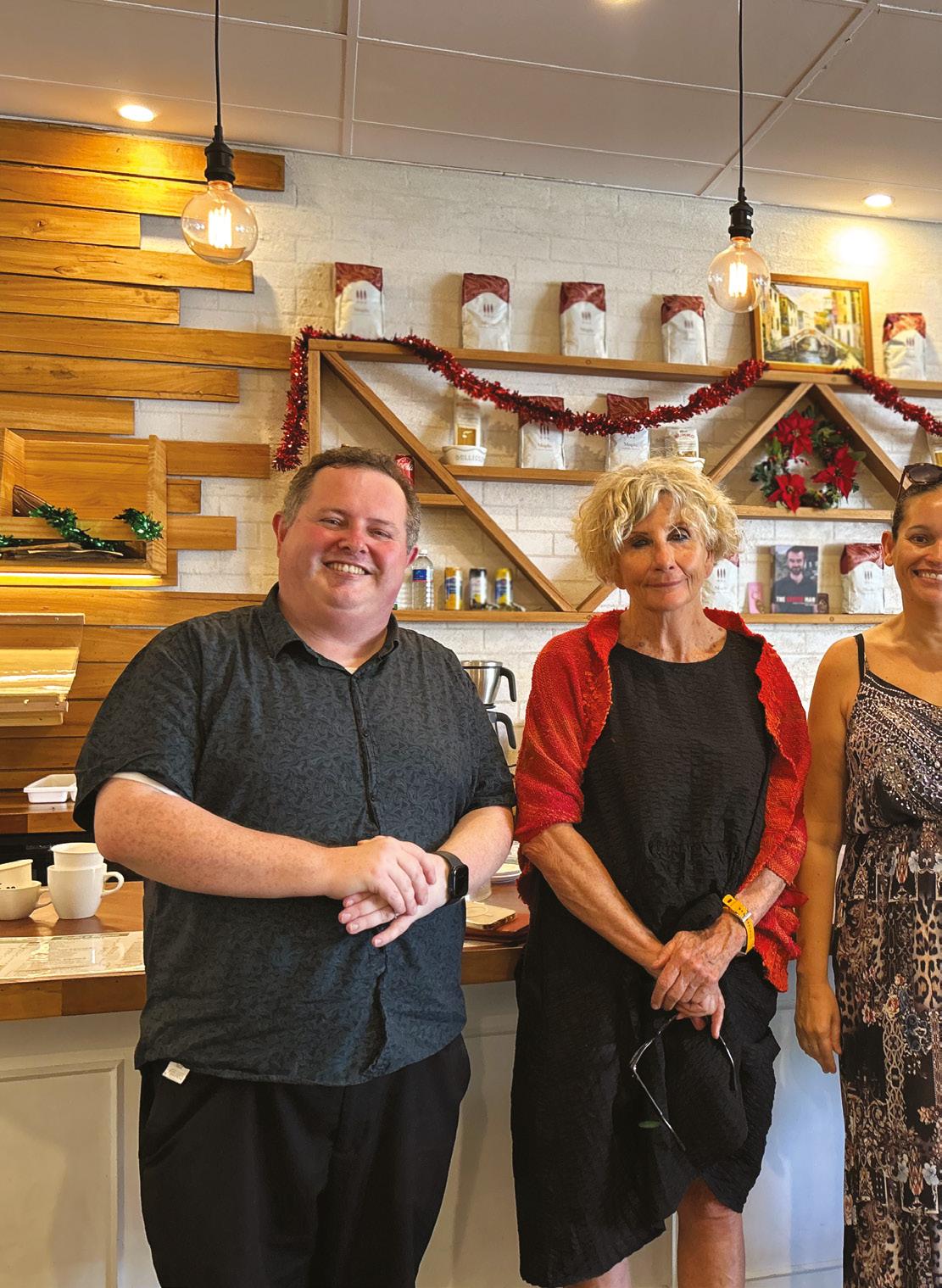

Prison chaplaincy is a sacred calling that requires qualities of caring and compassion.
In the Diocese of Lismore, prison chaplains embody what it means to be the ‘hands and feet of Jesus,’ providing hope, dignity, and spiritual guidance to those who find themselves forgotten by society. Through the ministry, chaplains bring the message of God’s unwavering love to those behind bars, reminding them that they, too, are worthy of grace, regardless of their circumstances.
Bishop Greg Homeming explains that prison chaplaincy is a mission that aligns with the fundamental calling of the Church.
“The extraordinary impact of prison chaplains is their ability to connect with prisoners who see themselves as worthless,” Bishop Greg says.
Bishop Greg describes prisoners as people “crying out to be noticed” after years of feeling forgotten. “If anyone is looking for connection because they’ve been forgotten and believe nobody cares, it’s in
the prisons. Saint Paul spoke about the different gifts that we all have; the gifts of teaching, administration, caring. If he was around now, he would say some are called to ministry in prisons.”
The Mid North Coast Correctional Centre is a minimum to maximum security hub for male and female inmates, based 14 kilometres west of Kempsey. Macleay Valley Parish priest, Fr James Foster, who’s a prison chaplain at the Centre, sees it as an important work of the Parish and Diocese, as it serves inmates, staff and their families.
“It’s a very privileged ministry,” Fr James says. “You are coming across people who are broken, lost, and haven’t had a chance in life.”
Karine, who is a trained counsellor and one of the chaplains at the Mid North Coast Correctional Centre, speaks about how it was the Lord’s plan for her. “It is a calling to be a chaplain and if that’s what you are called to do, follow your trust in God.”
Fr James says that the ministry extends beyond offering a listening ear; chaplains provide pastoral care as well as spiritual

guidance, helping prisoners find solace in Jesus’ closeness to them, whether by offering prayers or simply being present.
“We’re living Christ’s mission, as Jesus went to the people on the margins. There isn’t always interest in the broader society about helping those in prison, but they are still God’s children,” he says.
“Whether they are guilty or innocent, it is not for us to decide; it’s for them to see that they are still loved by God. All of us have our weaknesses— none of us are perfect,” Fr James adds.
While chaplains provide spiritual care for Catholics, their ministry extends to inmates of all faiths and backgrounds. “We’re there for Muslims, Hindus, Christians, agnostics, and atheists—we’re there for everybody, just like Christ was,” Fr James says.
The work of a prison chaplain is not confined to spiritual guidance; it involves building meaningful relationships based on trust and care.
Caroline, who is a trained psychotherapist, spiritual director and a chaplain at the Mid North Coast Correctional Centre, explains that their day-to-day work varies. From leading chapel services to responding to the ever-changing dynamics of prison life, chaplains navigate challenges like lockdowns, mental health crises, and shifts in prison policy.
“It’s about responding to situations as they arise,” Caroline says. “No day is ever the same, and some days can be particularly challenging, but we are there to listen and provide care as needed.”
Building trust with inmates is vital, as it opens the door for deeper conversations about faith and healing. Karine describes how inmates, over time, begin to seek her out, often after hearing from others about the support she offers. She runs programs that focus on positive lifestyle changes and ersonal growth.
“It’s about being humble, caring, compassionate and showing them dignity,” Karine explained. Their work is also a great support to the incredible services offered by counsellors, psychologists and other allied health professionals.
“We can do everything to support inmates while they are inside, but if there is no mental health assistance, they will always be traumatised and will never heal.”
The importance of building trust also extends to pastoral care of the staff. This is a fundamental part of the prison chaplain’s work as they minister as part of a team and seek to support all other members of the team.
The ministry is not without its difficulties. Chaplains can encounter challenges, such as staff shortages and procedural delays. These obstacles can be frustrating, especially when they disrupt the relationships they’re trying to nurture.
“In the past, I’ve organised to see an inmate, but due to a prison lockdown, I’ve had to cancel it,” Karine explains.
“It’s hard to build bonds when this happens.”
Fr James agrees, noting how busy the prison environment can be with many programs and work opportunities available for inmates as part of their rehabilitation.
“There is lots happening in the jail all the time, which is why we need to remind ourselves why we’re there and who we’re there for. Working together as a team is essential and there are so many wonderful and dedicated people working for the greater good of our society.”
Despite these challenges, Caroline adds that chaplains find gratification in their work, knowing they are making a difference in the lives of inmates.
“When you make that connection with people and you see how grateful they are, it is fulfilling.”
The emotional and spiritual toll of prison chaplaincy can be significant, leading to Karine and Caroline learning to rely on their Catholic faith to sustain them.
“Vicarious trauma is very real,” Karine admits. “Praying has helped me with the angst and frustration. I try and help as many people as I can every day, but I am only one person.”
Various opportunities for supporting each other are essential for fruitful ministry. Pastoral care of chaplains is provided through monthly pastoral supervision with an accredited and experienced pastoral supervisor. Other helpful supports include coffee catch-ups up with other chaplains at the Centre,
state-side gatherings and meetings of prison chaplains, as well as the annual NSW Catholic Prison Chaplains Retreat and national online gatherings of Catholic prison chaplains. These forums are also important for the sharing of ideas and resources in order to improve the provision of chaplaincy services.
Our prison chaplains are so grateful for the prayers offered for their ministry by people throughout the Diocese and beyond. It is a great source of strength for the chaplains in their daily work. Parishioners in the southern Deanery have been most generous over the years in donating quality clothing for inmates upon their release, as well as donating resources for use during programs.
All parishes have generously supported this ministry over many years through their financial support of the Diocese’s charitable works. Without this support, the ministry would not be as fruitful as it is today.
I was in prison and you visited me.
Matthew 25:36
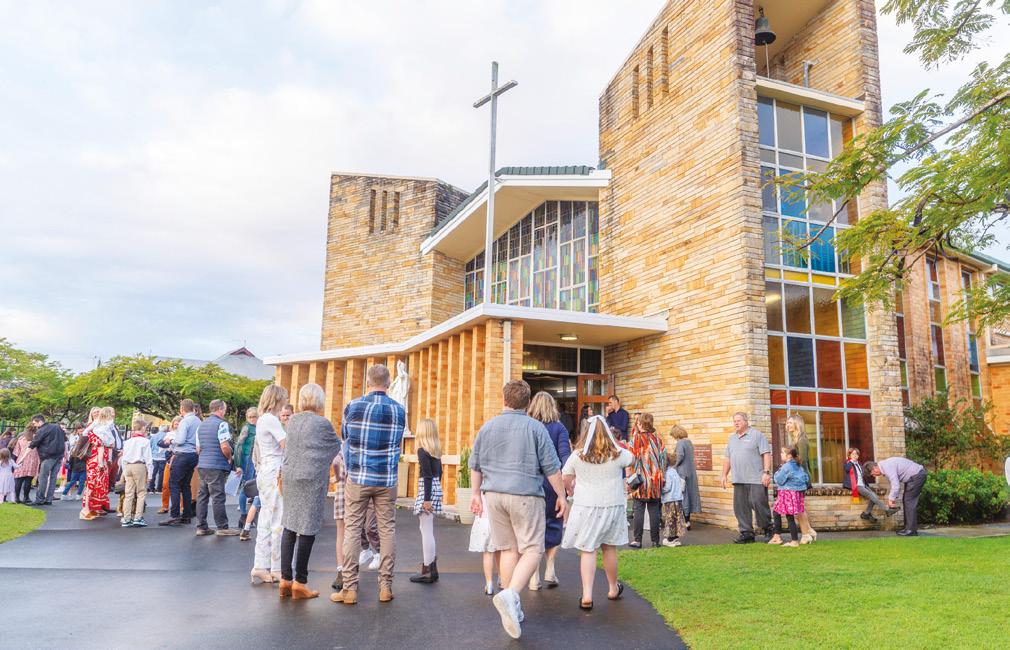
For over 60 years the DIF has been providing a source of funding for the parishes and institutions of the Diocese of Lismore. Money invested in the DIF helps people across the Diocese by supporting projects in health, aged care, education, pastoral activities, and parishes.
• Enjoy no fees or charges
• Interest is paid quarterly
• Easy to use online service and friendly staff
Diocesan Investment Fund (the Fund) is required by law to make the following disclosure: The Fund is not prudentially supervised by the Australian Prudential Regulation Authority nor has it been examined or approved by the Australian Securities and Investments Commission. An investor in the Fund will not receive the benefit of the financial claims scheme or the depositor protection provisions in the Banking Act 1959 (Cth). Investments in the Fund are intended to be a means for investors to support the charitable, religious and educational works of the Diocese of Lismore and for whom the consideration of profit are not of primary relevance in the investment decision. The investments that the Fund offers are not subject to the usual protections for investors under the Corporations Act (Cth) or regulation by Australian Securities and Investments Commision. Investors may be unable to get some or all of their money back when the investor expects or at all and any investment of the Fund are not comparable to investments with banks, finance companies or fund managers. The Fund’s identification statement may be viewed at www.dif.org.au or by contacting the Fund.




by Barry de Silva
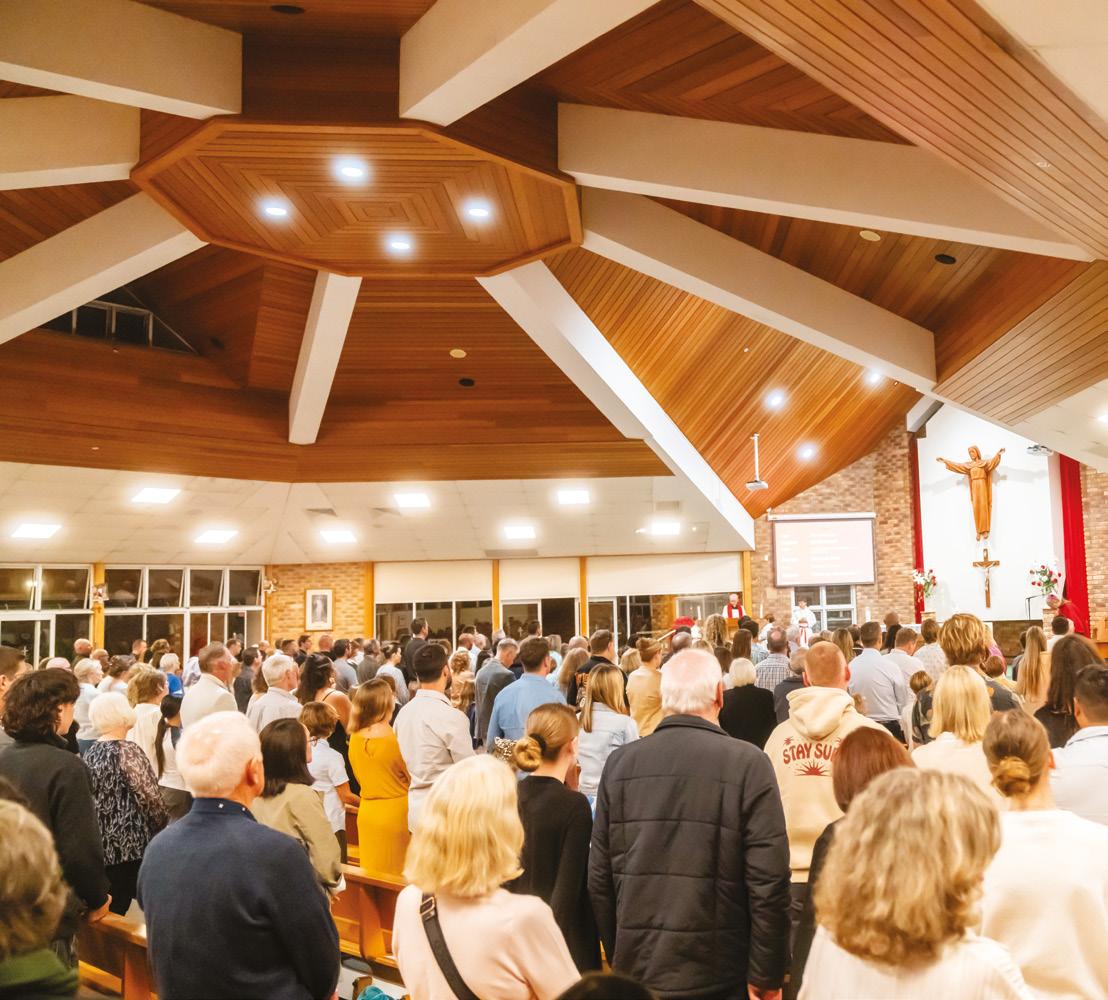
Sunday Mass has always been and will continue to be central in Catholic life and worship, but what happens when a priest is unavailable?

In the 1980s, fewer priests were available to preside over Sunday services, leading to lay-led liturgies becoming an essential part of many parishes.
The Vatican’s 1988 Directory for Sunday Celebrations in the Absence of a Priest laid the groundwork for such practices globally, and the Australian Catholic Bishops Conference adopted similar directives, which remain in use today. Bishop Greg Homeming acknowledges that these changes are inevitable
due to the decline in new priests and instances where priests may not be available.
“Given the smaller numbers of those joining the priesthood, parishes will need to be set up to cope with fewer priests. With our current clergy, there could be a situation that arises where the priest is away on leave or there is an emergency in a neighbouring parish,” says Bishop Greg.
“There will be places where it is only possible to have Mass once a month or at some other interval. On those Sundays a lay person will preside over a Liturgy of the Word, and Communion will be distributed. It is important for our communities to understand that these changes are inevitable and to be prepared for them.”
Providing parishes with the resources, protocols and processes for lay-led liturgy is a key part of the Diocese of Lismore’s Renewal Journey. Kurt Challinor, Principal of St Joseph’s Primary School in Alstonville, leads the lay-led liturgy team.
“We’re working with parishes collaboratively across the Diocese to discern their immediate and future needs in supporting lay-led liturgies,” explains Kurt. He notes that while these liturgies provide a spiritual outlet, they are not a replacement for the Liturgy of the Eucharist.
“It’s important for communities to know the difference between the two because they are very different.”
Feedback from parishes has been instrumental in shaping what form of support they need for lay-led liturgies. A recent survey had a 90% response rate, highlighting the diverse realities. “Some parishes have been doing this for years, while others are just beginning to explore it,” Kurt shares.
Fr Peter Slack, Parish Priest at St Mary’s in Casino, for over 20 years, recounts a similar history of lay-led liturgy over the years.
“Even when I first arrived, there were Sundays I couldn’t be in Casino because of my responsibilities in surrounding parishes,” recalls Fr Peter.
“It isn’t anything new, but it shouldn’t become the norm. When we are talking about the Liturgy of the Word from lay people, there are different ways these liturgies can take place. There is Liturgy of the Word with the distribution of Holy Communion, but it’s also recommended that in the week, in the absence of a priest, that Liturgy of the Hours, which is the daily prayer, be celebrated – and this can be done by anybody,” he adds.
“There are numerous examples in history where this has happened, so we shouldn’t think that these rituals are always performed on a Sunday in church. Since the Second Vatican Council, lay men and women, as extraordinary ministers of Holy Communion, have been bringing the sacrament to the sick.”
In the Diocese of Lismore’s document on Sunday Celebrations of the Word Gathering in the Expectation of the Eucharist, it is noted that the parish priest and parish decide what is needed by the way of lay leadership of the liturgy. After ascertaining the willingness of suitable people to undertake lay leadership of the liturgy, the parish priest will discuss the competency needed to perform this.
Once the parish priest has illustrated the ability of the nominated individual, he will request delegation from the Bishop. The final steps involve the Bishop sending the delegation of the new lay leader to the parish priest, and later being publicly commissioned as the lay leader of liturgy in the parish.
It is important to note that the Bishop’s delegation of lay leaders of the liturgy will specify the parishes in which the person is to minister, and the term of appointment –which is usually three years. In addition, the Bishop may specify the delegation is to lead Sunday and weekday liturgy, or to lead funeral liturgies, depending on the requirements of that parish.
At St Mary’s Parish in Casino, pastoral coordinator Steve Ellem has witnessed firsthand the importance of lay leadership. Steve recalls a time when Fr Peter’s flight was delayed, and he stepped in to ensure the service would proceed smoothly.

“Through a few resources, I was able to put together the order of service within the hour and run it past Fr Peter. It meant parishioners were able to listen to the Liturgy of the Word and receive communion on the Sunday.”
Steve sees lay-led liturgies as a key part of the future for St Mary’s and the wider Diocese.
“They help keep the community engaged, even when a priest isn’t available. If an entrusted person can read and has a good heart, then why can’t they be recommended as a suitable lay leader.”
Fr Joe DSouza, the administrator for Mary Help of Christians Parish in Sawtell, has seen the benefits of lay-led liturgy in nurturing spiritual growth, especially during the absence of the Parish’s former priest.
“Lay-led liturgy has kept our community together. It provides regular spiritual nourishment, even though it is not a complete substitute for the role of a priest.”
However, Fr Joe also highlights the challenges of identifying suitable leaders.
“It’s about more than just leadership qualities; it’s about living the life of Christ and embracing that role within the community.”
While lay-led liturgies cannot replace the Eucharistic celebration presided over by a priest, they ensure that parishioners continue to gather, worship, and receive Holy Communion. Kurt Challinor sums it up.
“We come together in the hope of celebrating the Liturgy of the Eucharist in the future.”
Through the Renewal Journey, parishes across the Diocese of Lismore are ensuring that the spiritual growth of communities continues, even when a priest isn’t available.




by Margaret Haydon
When 16 priests and lay people from Tweed, Kingscliff and Murwillumbah Parishes came together in September and October 2024 to explore ways in which they could collaborate, it was the first major milestone in a year long journey for just one of the six working groups established from the Diocese of Lismore’s Renewal Journey.
The delegates for this Regional Parish Collaboration workshop adopted the synodal approach of communal discernment in their discussions. Also in October, more than 30 parishioners from the Macleay Valley Parish gathered for their first ever Parish Assembly to consider the new strategic plan in response to the Renewal Journey. These are just two examples of an exciting new vision for the Diocese emerging through the Renewal Journey.
Commissioned by Bishop Greg Homeming, in consultation with the Council of Priests, the Renewal Journey was a response to calls from Pope Francis and the Australian Bishops’ Conference to seek answers to some of the questions that face not only the Diocese, but the Catholic Church throughout Australia.
One of the major questions is what should be the mission and focus of our parishes and Diocese, as we move further into the twenty first century?
The Renewal Journey, which is ongoing, is involving thousands of people from throughout the Diocese including priests, parishioners, school leaders and teachers, aged care and hospital staff, youth ministry teams and many others involved in the wide range of
Diocesan ministries. It calls for a conversion of the heart at the personal level before it can move to conversion of groups, structures and processes. Clergy has a uniquely important and irreplaceable role in the Renewal helping parishes to walk the path of synodality.
During 2022, the team leading the Renewal visited parishes and held interactive sessions with parishes and priests. They also conducted a parish vitality survey, to which more than 950 people responded. Throughout 2023 and 2024, each parish in the Diocese was visited, consultations were held with both priests and lay people and the results of the survey were presented along with a view on the parish’s organisational capability and financial



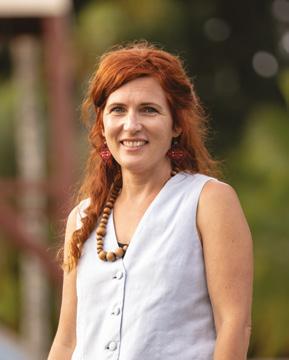
health. From the consultations, several themes for action emerged with participation of both clergy and laity in the design of solutions for the Diocese:
• Renewal of the Diocesan youth ministry;
• Exploring inter-parish collaboration via regional workshops;
• Preparation of layled liturgy material, protocols and processes for parishes;
• Design of protocols and processes for clergy induction into the Diocese;
• Design of clergy and parish profile templates for introduction of new clergy into a parish;
• Stronger communication.
More parishes are re-energising their parish pastoral councils focusing on bridging the gaps identified in the survey.
Leading the Youth Ministry team are Travis Lyon from Lismore Parish, Chair of the Lismore Parish Pastoral Council and a teacher at Trinity Catholic College; and Gemma Ballantine from
Mullumbimby Parish. Gemma, who’s Assistant Principal for Mission at St Anthony’s Primary School in Kingscliff, said that the Renewal has gathered a terrific team from across the Diocese to look at ways the church can be alive in the hearts of our young.
“We’re not focused on why they don’t come to church, we are looking at how we, as a parish and a Diocese, can ignite their spirits and bring them closer to God.”
Kurt Challinor, Principal of St Joseph’s Primary School in Alstonville, leads the Layled Liturgy team and said that the group is working collaboratively with parishes across the Diocese to discern their immediate and future needs in supporting layled liturgies. The team is currently preparing videos to introduce lay people to lay-led liturgies and the steps in formation. Through the Renewal Journey, parishes across the Diocese are ensuring that the spiritual growth of communities continues, even when a priest may not be available.
Recent changes resulting from the Renewal have seen the appointment of Barry de Silva as Communications
Scan to learn more about the Renewal Journey
Officer for the Diocese and Dr Madeline Beveridge as the Renewal’s Pastoral Projects Leader. Madeline said she has been inspired by the clergy and laypeople who have been working voluntarily for more than twelve months.
“Fundamental to the success of the Renewal Journey is accompaniment between clergy, Diocesan staff, and parishioners-journeying together as people for God as we seek to continue to build a vibrant faith community in our Diocese,” said Madeline.
She added that as a Church we need to embrace change and quoted the words of Pope Francis who said that “change and reform is in the very nature of a church that is called to be missionary”.
Bishop Greg has invited people across the Diocese to be part of the process, regardless of whether they are clergy, laity, or people working in ministries and workplaces.
“When we work together, when we listen to each other, when we discuss, we immediately begin to see what is missing, what we need to do, what we need to correct, and as we acknowledge and find this, already the Diocese is changing,” said Bishop Greg.
by Thomas Evans

As the 2024 school year came to an end, schools across the Diocese came together to celebrate the impressive accomplishments of their graduating year 12 students, marking the end of a 13-year journey through Catholic education.
Atotal of 1,136 students graduated from our Catholic schools this year, with 1,028 completing their Higher School Certificate (HSC) and 395 pursuing Vocational Education and Training (VET) certifications or School Based Apprenticeships and Traineeships (SBATs) across a diverse range of fields.
As a reflection of their academic commitment, 61 students received early university offers, while 12 were awarded scholarships that paved the way for strong educational and career pathways. These early offers and scholarships are not only

a testament to the student’s hard work and dedication but also to the supportive educational environments within these schools; which encourage students to pursue higher education and achieve their goals with confidence.
This year, students across the Diocesan Colleges earned prestigious awards, with 64 students recognised for their excellence in academics, leadership, community service, sports, and the arts. Many students were honoured with awards for leadership, including the ADF Long Tan Leadership and Teamwork Awards, and the ADF Future Innovators










Graduated from our Catholic schools
Graduated from our Catholic schools and completed their HSCs
Pursued Vocational Education and Training or School-Based Apprenticeships and Traineeships
Awards; celebrating their contributions to Science, Technology, Engineering, Mathematics (STEM) and innovative pursuits. Along with various community service honours, it highlighted students’ commitment to making meaningful impacts within their communities.
Academic excellence was further celebrated through students being offered scholarships at Southern Cross, Newcastle and New England Universities. Vice Chancellor’s High Achievement Prize. In sport, students demonstrated remarkable talent at state, national and international levels, earning distinctions in rugby league, cricket, and gymnastics, with several representing their schools and achieving notable success in competitions, including at the Paris Olympics.
The arts also shone as a focal point, with students securing nominations for prestigious HSC showcases SHAPE, OnStage, and Encore, spotlighting exceptional talents in design, technology, drama and music.
These achievements reflect the incredible dedication, hard work, and diverse talents of the students, leaving a lasting legacy as they move from school to their next chapter with a wealth of accomplishments and a strong foundation for future aspirations in their lives.
Scan to read more stories from our Catholic schools

In November, year six students from St Joseph’s Primary School, Woodburn, were invited to breakfast with the Governor-General, Sam Mostyn, during a recent excursion to Canberra. The experience was further enriched by a tour of Government House led by knowledgeable staff, including the Aide-de-Camp to the Governor-General.
This special experience was the highlight for students during their four-day adventure in the nation’s capital. The smiles and excitement captured in the photos say it all.


by Mark Baker

St Vincent’s Lismore is a ministry of the Diocese of Lismore, and the only independently owned and operated Catholic hospital in Australia.

For over 100 years, St Vincent’s Private Hospital in Lismore has provided compassionate, person-centred care for the people of the Northern Rivers. Our care is well recognised by the community and, like the whole Diocese, St Vincent’s is undergoing a significant renewal.
CEO Alan Cooper is leading a transformative phase, investing in physical upgrades and cultural programs to enhance patient care and staff wellbeing.
“It’s been a great opportunity to rejuvenate the organisation. Looking not only at the
aesthetics of the environment, but improving the capability of our managers, future managers, and all of our employees, to provide enhanced services to the people we serve in Lismore and surrounding regions,” Alan shared.
“Our list of achievements over the last 12 months is impressive, but we are only part way there. Now we have a vision for the future, and we’re excited to re-establish St Vincent’s as a leading player in health care for the Northern Rivers.”
Bishop Greg Homeming congratulated staff on
their dedication.
“There’s more here than medical care because the healing of the body is only part of what a Catholic hospital does,” Bishop Greg said.
“As a Catholic hospital, we care for the total person. That’s exactly what the Gospel and exactly who the person of Jesus Christ represents; the wholeness, the fullness of what it is to be a human being. That’s what you attend to here - the wholeness of the person. And each of you in your own way provides for that. Therefore, I thank you, and I encourage you to continue on this path.”

To keep the hospital’s facilities welcoming and functional, St Vincent’s is making a series of upgrades due for completion by the end of 2024. New carpet, fresh paint, updated signage, and new furniture, alongside bathroom and lift renovations, are designed to reinvigorate the environment. These upgrades reflect the hospital’s commitment to providing an exceptional experience for patients and their loved ones.
In addition to physical changes, St Vincent’s is furthering its culture of excellence through the new StriVe Strategy, which cleverly incorporates ‘St V’ in its name. Compassion modelled on the example of Jesus Christ has always been a core value of St Vincent’s, and is now joined by respect, integrity, courage, and kindness. The strategy encourages staff to prioritise positive behaviours, wellbeing and high performance within themselves and for their teams.
“We’re making St Vincent’s a workplace of choice for health professionals in our area, a place where staff are excited to come each day, confident, competent and empowered to excel in their areas, and to grow as individuals”, Alan said.
St Vincent’s is also working to build stronger community ties, with an expanded presence on social media to keep locals informed about new services and hospital news. These efforts position St Vincent’s as the go-to

private healthcare option in the region, inviting residents to experience ‘best care, right here’ in the Northern Rivers. As a private patient you can request an immediate transfer to St Vincent’s Lismore from any emergency department in the region once your condition has stabilised. All you need to do is make the request to the doctor in care, and the hospital administration will arrange your patient transfer. They will check with St Vincent’s first to ensure bed availability and fund cover. They currently have capacity and look forward to seeing you.
A recent Australian Council on Healthcare Standards assessment underscored the excellence at St Vincent’s, with the hospital achieving full compliance across eight National Safety and Quality Health Service Standards. This perfect score, accomplished with zero unmet requirements or recommendations, reflects the high standards of safety and care that St Vincent’s strives to uphold.
Supported by skilled specialists and ongoing investments in infrastructure, St Vincent’s is committed to delivering advanced care close to home. Bishop John Carroll had a vision to provide the best level of care to the Northern Rivers, and 103 years later the hospital continues this proud tradition of service, presenting St Vincent’s Lismore as a trusted healthcare partner dedicated to excellence.
Find out more about St Vincent’s Lismore
by Kelli Potts

The Diocese of Lismore has a long and proud history of providing aged and community care. Traditionally these services have been delivered through residential aged care, nursing homes and hostels, and community care; which is made up of a range of services delivered in-home. These services are funded and regulated by the Federal Government and come under the Aged Care Act 1997
Independent living villages are another key element of Diocesan aged care, as accommodation for older people. Many of you may be more familiar with the name ‘retirement village’.
They are known under many different names which often vary depending on the services or facilities they offer their residents. These villages attract no government funding and are regulated in NSW under the NSW Retirement Villages Act.
The Diocese has a large aged care footprint on the east coast, from Ballina and Lismore in the north, to Port Macquarie in the south.
The Diocesan Aged and Community Care Secretariat (DACCS) works together with our providers to ensure we not only meet our regulatory requirements but build better organisations through sharing of expertise.
The annual DACCS conference illustrates this work in action. There are a total of four residential aged care and four community care services in the Diocese:
• St Joseph’s Nursing Home – St Vincent’s Private Hospital, Lismore (residential aged care)
• St Carthage’s Community Care – St Carthage’s Cathedral Parish, Lismore (community care and independent living)
• Crowley Care – St Francis Xavier Parish, Ballina (residential aged care, home care and independent living)
• Sawtell Catholic Care of the Aged – Mary Help of Christians Parish, Sawtell (residential aged care, home care and independent living)
• St Agnes’ Care and Lifestyle – St Agnes’ Parish, Port Macquarie (residential care, home care and independent living)
In addition, there are large and small independent living villages, run by parishes for their communities. They play a vital role in supporting safe and suitable accommodation for older people. Aged care has been a frequent topic in the media over recent years, from the Aged Care Royal Commission and the COVID-19 pandemic to the new Aged Care Act currently under review by the Federal Government.
Unfortunately, aged care is often portrayed negatively, which can lead older people to feel apprehensive about entering care, accepting in-home support, or moving into a village community. We are proud that the aged care services across the Diocese were not subject to
investigation in the Aged Care Royal Commission. In fact all have longstanding reputations for providing high-quality care, services, and accommodation within their communities. It is this vision of bringing quality Catholic care to their community that is the true mission of aged care in the Diocese and this continues to motivate DACCS providers to strive towards continuous improvement and innovation. In 2024 this has taken many forms including just a few of the highlights below:
• The new Emmaus Village in Port Macquarie (see article on page 34), and the expansion of their home care services to provide more flexible and personalised options to better support clients. These highlight a focus on prioritising financial sustainability, infrastructure development, and innovation.
• St Joseph’s Nursing Home at St Vincent’s Private Hospital has been undergoing a renewal with the conversion of older four bedded rooms. These areas are being transformed into four single occupancy rooms, each with private ensuites.

• St Carthage’s Community Care in Lismore is well known for its range of in-home care and NDIS respite care services. They also have St Matthew’s self care units in Goonellabah and Marion Court independent living units in East Lismore
• Crowley Care in Ballina has prioritised ‘reconnection’ through the recommencement of events and community activities for our residents, clients, families, staff and parish community, following the pandemic. The commencement of construction on the new 26 independent living apartment development has been a significant milestone. It will provide additional independent living housing in Ballina, where demand remains high.
• Sawtell Catholic Care have had a remarkable year winning the AIH National Award for community engagement, while also achieving accreditation as an NDIS provider. The Link and Link Café continues to grow in popularity in the local community, and was the venue for the annual DACCS conference earlier this year.
All of this was achieved whilst implementing ongoing industry regulations, compliance, reforms, and health and support workforce challenges. We are fortunate that the Diocesan aged and community care teams work together to meet these challenges and continue to look forward for the opportunities to grow the ministry of aged care across the Diocese.
by Megan Barber

Today, there are an estimated 421,000 Australians living with dementia.
For families with a loved one affected by the illness, offering support with compassion and respect during this stage of their life is so priceless.Emmaus Village and Community Centre, which offers an innovative alternative mode of care for people living with dementia, was officially opened at 16 Colonel Barney Drive in Port Macquarie on 2 October 2024.
Based on best-practice models such as the world-leading Hogeweyk model in the Netherlands, Emmaus Village focuses on maintaining a sense of normalcy and fostering community, ensuring residents can live comfortably in a secure environment that supports their needs. Co-located with Emmaus Home, an existing St Agnes’ Catholic Parish owned and operated residential aged care service, Emmaus Village is purpose-built to support up to 94 people living with dementia. When fully occupied, the village will employ the equivalent of 75 full-time staff across a variety of roles. Set within a secure
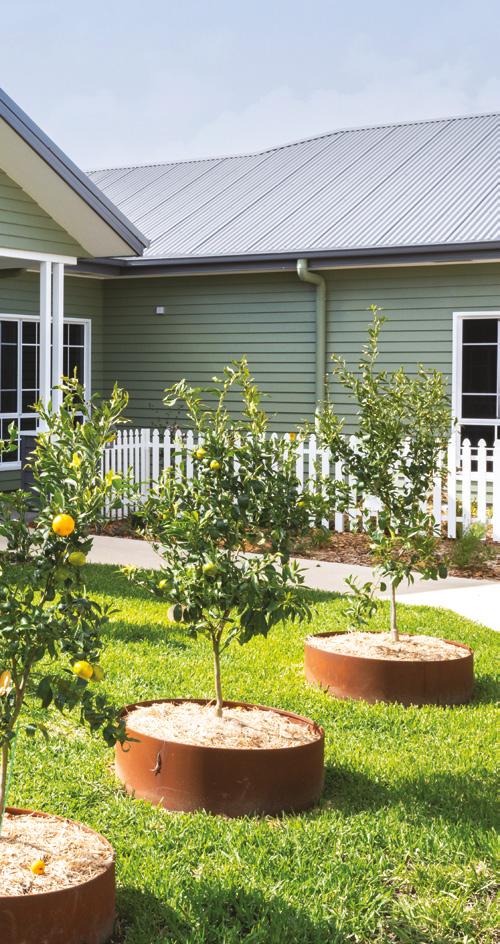
1.6-hectare space, Emmaus Village features twelve houses and a vibrant community centre with a café, corner store, salon, and cinema.
Beautifully landscaped grounds encourage residents to move freely, socialise, and share interests, enjoying the comforts of home alongside communal spaces such as the potting shed, vegetable garden, bocce court, citrus orchard, and BBQ areas.
St Agnes Parish CEO, Tony Leahy highlighted the significance of the facility.
“Our goal is to provide a living environment where individuals with dementia can


thrive, while maintaining their independence and enjoying a high quality of life,” Tony explained.
“The success of Emmaus Village design and construction is a testament to what can be achieved when we combine innovative ideas with strong community and government support. Our first residents are settling in well with improvements being noted in their overall health and wellbeing.”
The project was made possible through a combination of funding sources, with St Agnes’ Parish securing approximately one-
third of the funding through government grants. The NSW State Government contributed $5m for the Community Centre, while the Australian Federal Government provided $6.5m from the ‘Building Better Regions Fund’ for the construction of the twelve homes, which make up the small household model.
Scan to learn more about Emmaus Village
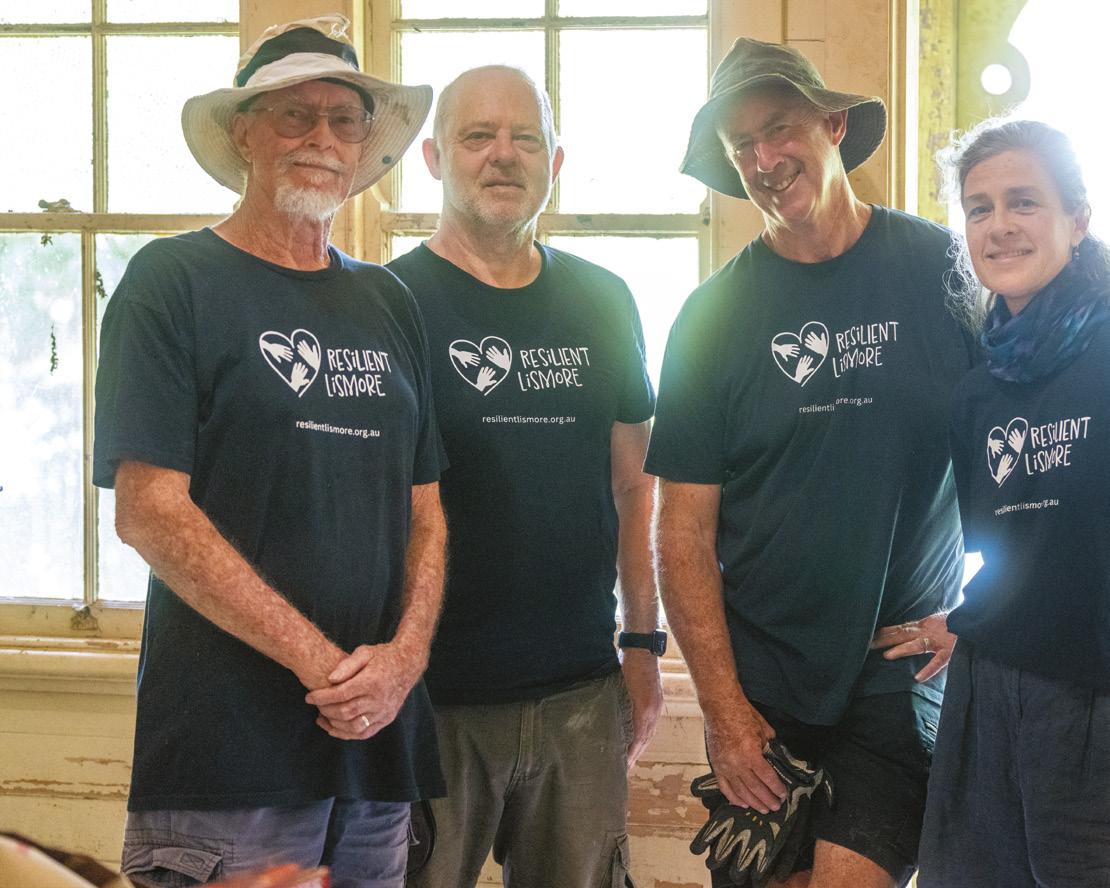
$651,225
DONATED TO NOT-FOR-PROFIT GROUPS OVER THE LAST 12 MONTHS
In 2022, Bishop Gregory Homeming launched The Diocese of Lismore Flood Appeal, leading to local and international donations totalling over $1.7 million. To support those affected by the disaster, funds from the Appeal and the Diocese have been donated to the following organisations:
With over $455,000 in funding from the Diocese, Resilient Lismore has redeveloped over 600 homes and supported more than 13,000 people across towns and villages including Casino, Chinderah, Coraki, Kyogle, Lismore, Murwillumbah, Nimbin, Wardell, and
Woodburn through initiatives like the Repair to Return project.
Operating in Lismore from Monday to Friday and in Goonellabah every Wednesday, The Good Pantry offers low-cost grocery items, and free bread, fruit, and vegetables to its 2,500 members. The Diocese has contributed $250,000 to support this low-cost food market service.
The community service organisation has supported more than 217 Richmond

Valley residents through rental and mortgage assistance and other necessary expenditure.
The Diocese has helped assist Social Futures by donating $510,000.
Focused on preventing homelessness in the Tweed Valley, Momentum Collective has received $250,000 from the Diocese to support their Private Rental Subsidy Program.
Each of you should use whatever gift you have received to serve others, as faithful stewards of God’s grace in its various forms.
1 Peter 4:10
To help the Parish recover from the loss of 42 independent living units during the floods, the Diocese has donated $140,000 to support displaced residents.
The Diocese has given $100,000 to the Rotary Club to assist flood-affected residents in the Lismore region.
In partnership with the Foundation, the Diocese has donated $50,000 to support smaller charitable groups impacted by the floods.
There is still a residual amount of funds from the Appeal available, which will be allocated to these organisations and other groups over the next 6-12 months.
Beyond the Lismore Flood Appeal and through the Benevolent Fund, the Diocese has supported Macleay Valley Parish with The Craft and Cooking Group project through the Kempsey Neighbourhood Centre, to assist people isolated through domestic violence, financial disadvantage, and
mental health challenges. The Diocese has also acquired properties in Goonellabah to be utilised as a warehouse for Resilient Lismore and The Good Pantry; and for volunteers from Resilient Lismore to stay at. Invercauld House, which offers retreats, accommodation and conferences, continues to offer a special discount rate to not-for-profit organisations.
The Mullumbimby Parish have provided use of the Brunswick Heads Church to Bruns Brekkie, a volunteer run organisation that supports vulnerable people in the Brunswick Heads community with breakfast every Tuesday and Friday from 8-9am The Tweed Heads Parish have been supporting those in need within their local community through two initiatives—the Parish Pantry and Lunch with Friends. Read the article on page 38.
In partnership with five other churches in the area, Alstonville Parish has been coordinating LinC (Love in the name of Christ), an organisation of 45 trained volunteers that assists elderly people with social interaction, shopping, transport to appointments, support after being in hospital, and emergency assistance.
In the last five years alone, LinC has completed over 1,000 jobs for locals.
by Barry de Silva

In The Joy of the Gospel: Evangelii Gaudium, Pope Francis declared that “none of us can think we are exempt from concern for the poor and for social justice”.
Parishioners at St Joseph’s Parish in Tweed Heads have embraced this message by supporting those in need within their local community through two key initiatives—the Parish Pantry and Lunch with Friends.
Donna Walsh and John Storey from St Joseph’s share how these programs offer more than just food; they serve as a lifeline for many.
For the past two years, the Parish Pantry has been providing non-perishable food items to anyone in need, from Monday to Thursday, regardless of their background.

“We have a group of volunteers who come in every week to help pack the food items for people,” Donna said.
“We help families who may be struggling, as well as people from the wider community.”
In addition to individual assistance, the parish also provides food packages to those in government-funded assisted accommodation.
Donna credits the success of the pantry to the generosity of parishioners of St. Joseph’s who continually donate.
“We’ve been fortunate to have their support, which has meant the pantry has been well stocked —we’ve always had enough food for everyone,” she added.
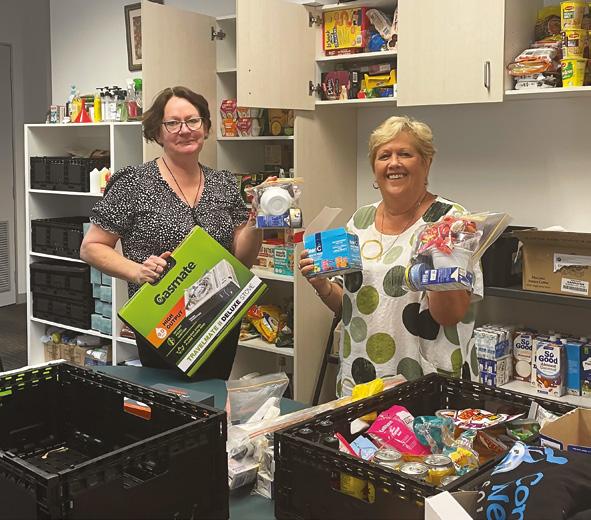
John Storey and Pat Twohill coordinate the Lunch with Friends initiative, which began in 2006 when two parishioners, Bill Lovering and Denis Pommer, identified a need to provide meals for the homeless in local parks.
“It started as a way of giving back to the community, so they began cooking sausages on the beachfront at Coolangatta every Thursday, and then moved to Goodwin Park in Coolangatta” John explained.
Over time, Lunch with Friends evolved and partnered with Fred’s Place, a drop-in centre run by St Vincent de Paul that offers meals, shower facilities, and laundry services for disadvantaged people. Every Tuesday, volunteers gather in the parish kitchen to prepare 60 ham and salad rolls, which are then delivered to Fred’s Place. Lunch with Friends has also received vital support from two local clubs through the NSW ClubGRANTS Program, providing 100 hot meals, which are distributed at Fred’s Place every Thursday.
“We’ve been seeing more older women coming to collect food, possibly because of the rising cost of living. Often they just need that extra support, and Fred’s Place does a great job by offering frozen food as a supplement to the fresh meals.”
The Parish Pantry and Lunch with Friends share a common mission—to ensure no one in the community goes hungry. For John, it’s more than just food. “It’s all about helping people and volunteers understanding the disadvantage in the area,” he said.
“It’s only a small token of what can be done, but we make sure no one goes without food. It also gives those we’ve helped a sense of knowing that people care for them.”
‘Never see a need without doing something about it.’
Mary MacKillop
By giving to the Diocese of Lismore, you are helping us continue in our mission of faith, hope, and charity. Tax deductible donations go directly to the Diocese of Lismore Benevolent Fund to provide support for people who are experiencing hardship
This is to support people and not-for-profit organisations that may be experiencing hardship due to factors such as financial strain, unemployment, or crises that disrupt their daily lives. This includes people affected by homelessness, those seeking refuge from domestic violence, and individuals in need of support as they look to rebuild their lives.
and are most vulnerable. Every dollar that is generously donated to the Benevolent Fund will be used for charitable purposes. The Diocese has three funds that you can contribute to:
Donations are used to help people in our communities that have been impacted by disasters and emergencies. The funds will be used to help individuals and families with accommodation, food, clothing, health and other related services.
The prison chaplain ministry provides hope, dignity and spiritual guidance to inmates who are forgotten by society. Prison chaplains are employed by the Diocese, and their wage costs are funded by a NSW Government grant. Donations will be used to cover operational costs; allowing chaplains to fulfil their roles as the hands and feet of Jesus.

by Lew Wallace

Catholic Mission is the Pope’s mission agency in Australia – one of the 160 Pontifical Mission Societies in the world. Our mission is to proclaim the Gospel of Jesus, serve the poor and those in need, and to act for justice, peace and creation in collaboration with local churches, so that all people can experience life to the full.
Our main area of activity is in development aid. Catholic Mission collaborates with bishops, priests, religious brothers, nuns, and lay Catholic faithful from around the world to develop and fund
their grassroots projects in education, healthcare, agriculture and community welfare.
Catholic Mission receives projects from the Pontifical Mission Societies in Rome, and also directly from bishops, priests and religious representatives.
In January this year I had the immense privilege and opportunity to visit projects in which Catholic Mission has participated in Cambodia. The tremendous impact of those who have given generously, was very evident.



At the Arrupe Centre, a welcoming home where youth with disabilities are provided with education, healthcare and support, we spent a wonderful evening with 24 beautiful children.
Established by Bishop Kike in 2001, the Centre educates and accommodates the children, preparing them for a fruitful, and meaningful life. Once the children have completed their education, they can obtain employment at the Textile Factory for People with Disabilities, the Lonely Tree Café or Oh Battambang Boutique Hotel. Catholic Mission aims to work with our partners so that there are pathways from education into employment –an interconnectedness of projects.
We witnessed the beauty of the Khmer blessing dance being performed by four students in wheelchairs with
their lovely housemother, a testament to the holistic education which they receive.
The poorest of students receive a wonderful education in hospitality or agriculture at the Saint Francis Technical School, Phnom Penh Prefecture. This school boasts a 100% graduation rate and students are able to undertake both work experience and employment at the Phnom Voah Farm which boasts a restaurant, accommodation, bamboo train, rose farm, plantation of mangoes, kampot pepper and other fruits and vegetables, goat and wild boar breeding – a mecca for tourists and plentiful employment envisioned by Bishop Olivier Schmitthausler, the Apostolic vicar of Phnom Penh.
Through the support of generous donations, Catholic Mission assisted 131 projects
in 28 countries during the 2023/24 financial year. In the Diocese of Lismore, $31,640 was raised in the World Mission Month Appeal and $24,982 in the Socktober campaign in our schools to resource the Maria Auxiliadora Medical Clinic in Timor-Leste with life-saving medications, baby food and staffing needs.
We sincerely thank parishioners, school mission leaders, school children, businesses, and other entities, who made this possible.
Scan to donate to Catholic Mission:
The Most Reverend Gregory Homeming OCD has made the following appointments in the Diocese of Lismore:
Father David Gilbey, Northern Deanery (Tweed Heads, Kingscliff, Murwillumbah, Byron, Mullumbimby, Ballina, Alstonville, Coraki, Lismore, South Lismore, Kyogle, Casino);
Father Joseph Holloway, Central Deanery (Maclean, Clarence Valley, Coffs Harbour, Sawtell, Bellingen, Nambucca Valley);
Father Paul Gooley, Southern Deanery (Macleay Valley, Port Macquarie, Wauchope, Camden Haven).
Father Peter Karam, Parish Priest emeritus, South Lismore Parish
Father Roland Agrisola, Administrator, Maclean Parish
Father Nicolas Maurice, Assistant Priest, Tweed Heads Parish
Father Alejo Despacio Jr, Assistant Priest, Port Macquarie Parish
Father Joe DSouza OCD, Administrator, Sawtell Parish (in addition to Administrator, Coffs Harbour Parish)
Father Joy D’Souza OCD, Assistant Priest, Sawtell Parish
Father Bing Monteagudo, Administrator, South Lismore Parish (in addition to Administrator, Cathedral Parish)
Father Wilber Tobe, Assistant Priest, Casino Parish
Father Phillip Borla CICM, Assistant Priest, Cathedral Parish

Guided the wise men to Jesus Celebrates the visit of the wise men
An extraordinary event, such as Christ’s birth
Another term for Christmas, often used in songs
Means “God with us”
Title for Jesus, who saves humanity
To listen attentively, often associated with angels
The town where Jesus was born
Deep respect and worship
Good news or messages, often related to Christmas
Message proclaimed by the angels
Across
Wise men who brought gifts to Jesus
First to hear the news of Jesus’ birth
Where Mary placed the baby Jesus
Heavenly beings announcing Jesus’ birth
Mother of Jesus
The season of preparation before Christmas
Song sung by angels at Jesus’ birth
The scene of Jesus’ birth
central message of the Christmas story




